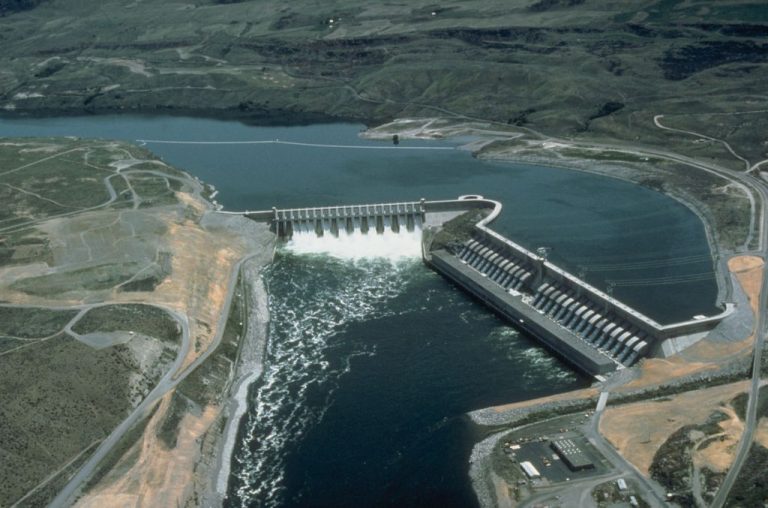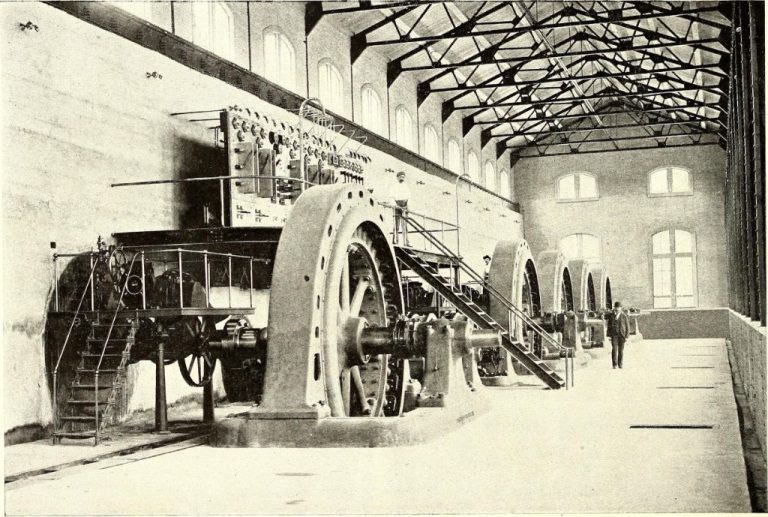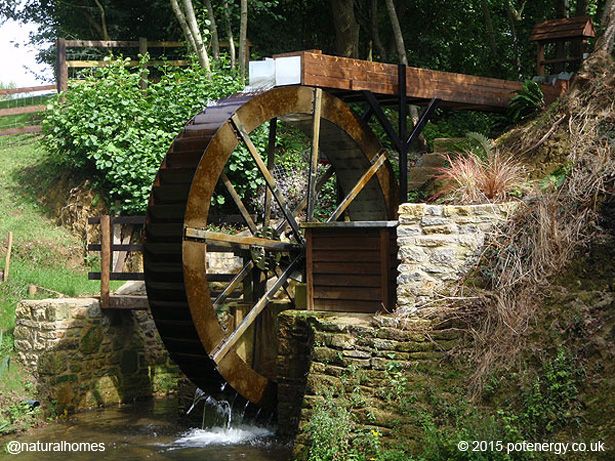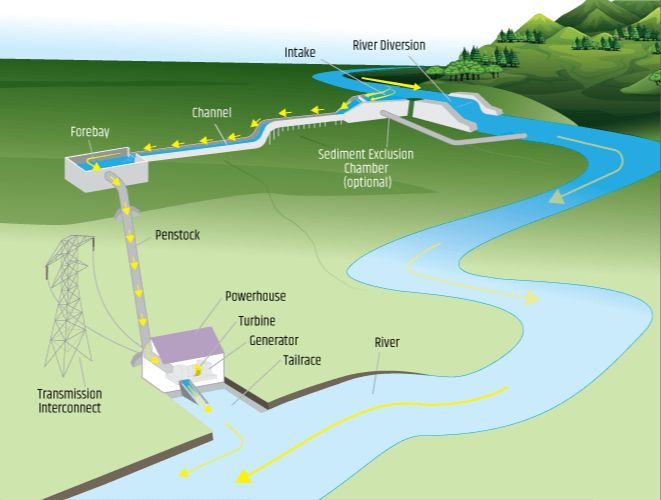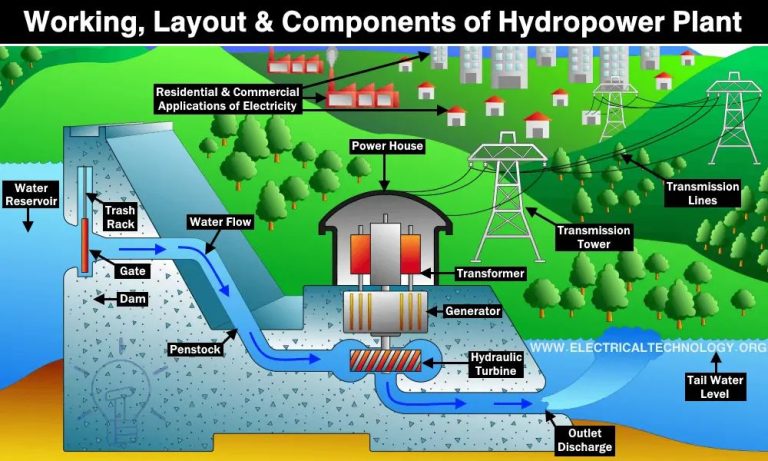How Can We Make Hydropower Better?
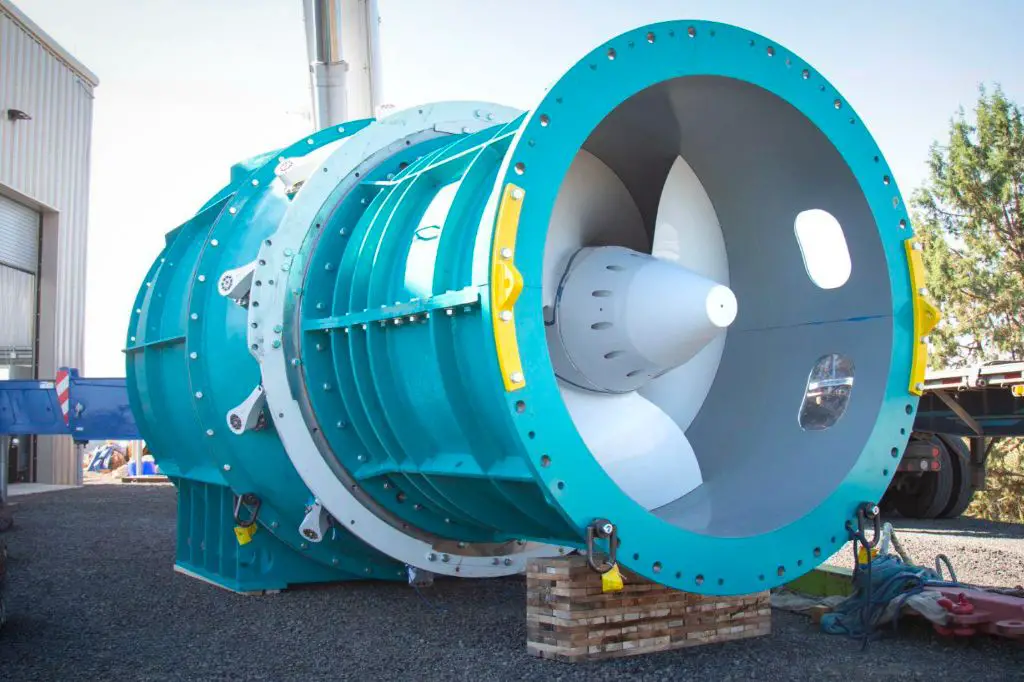
Hydropower is the process of generating electricity by using the energy from flowing water. It is one of the oldest and most widely used renewable energy sources in the world. As of 2021, hydropower provided over 16% of the world’s electricity and over 70% of all renewable electricity generation [1]. The three main types of hydropower plants are run-of-river, reservoir storage, and pumped storage. Run-of-river plants generate electricity from the natural flow of a river while reservoir plants regulate water flows using dams and reservoirs. Pumped storage plants pump water uphill to a reservoir during periods of low electricity demand and release it downhill through turbines when electricity is needed.
While hydropower is a proven technology with a long history, it faces challenges today. Dam construction often displaces communities and alters local ecosystems. Droughts and climate change threaten hydropower output in some regions. Public opposition has slowed dam building in many countries. However, hydropower remains essential for clean electricity, energy storage, and grid stability. With sustainable practices and innovative technologies, hydropower can play a major role in the renewable energy transition.
Improving Sustainability
One key way to make hydropower better is by improving its sustainability and reducing its environmental impacts. Hydropower dams can negatively affect rivers and wildlife by altering natural water flows, blocking fish migration routes, and changing downstream water quality and temperatures (UCSUSA). Some strategies to mitigate these effects include:
- Implementing fish ladders – these allow fish to bypass dams and access upstream spawning grounds. Fish ladders have been successfully used around dams in many countries.
- Maintaining minimum flow regimes – releasing minimum amounts of water downstream to sustain river habitats and wildlife. Guidelines help strike a balance between energy generation and ecosystem needs.
- Retrofitting dams – updating old hydropower infrastructure for greater efficiency, capacity and environmental performance. This extends the lifespan and sustainability of existing projects.
With careful planning and mitigation strategies, hydropower’s sustainability can be improved. Striking a balance between energy production and river health is key (FWEE). The results can be win-win solutions that provide renewable energy while also protecting wildlife and ecosystems.
Upgrading Old Infrastructure
One way to improve hydropower sustainability is by upgrading and refurbishing old infrastructure instead of building new dams. Modernization projects that upgrade turbines, generators, control systems and other equipment can help expand the capacity and lifespan of existing hydropower facilities (https://www.hydro.org/waterpower/modernizing/).
Refurbishing hydroelectric plants with new, efficient turbine runners, generators, and automated control systems can boost output and extend the service life of projects by 20-30 years or more. For example, refurbishing seven old hydropower plants in the Austrian Alps increased total capacity by 78 MW, enough to power over 150,000 households (https://www.renewableenergyworld.com/baseload/refurbishing-hydropower-to-increase-project-life-and-boost-capacity/).
Comprehensive plant upgrades and lifetime extension services can help existing facilities achieve up to 30% more power output. This “reset and upgrade” approach gives hydropower plants a second life in an economical and sustainable manner (https://www.ge.com/renewableenergy/hydro-power/services/reset-upgrade).
Developing New Technology
There are several promising new hydropower technologies that can improve efficiency, flexibility, and sustainability. Advances in pumped storage allow for greater energy storage capabilities to better integrate intermittent renewables onto the grid. New run-of-river and small hydro systems can generate electricity with minimal environmental impact.[1]
Floating solar panels on reservoirs can allow for dual-use infrastructure and prevent evaporative losses. Integrating storage into existing dams through pumped hydro storage retrofits or by adding batteries can boost output during peak demand.[2] Modular and standardized turbine designs allow for rapid deployment. Variable speed turbines can optimize efficiency across a wider range of flow conditions.[3]
Overall, new hydropower technologies aim to maximize power generation and grid reliability while minimizing environmental impacts. With continued innovation and deployment, hydropower can play an even greater role in the renewable energy mix of the future.
Optimizing Grid Integration
As variable renewable energy sources like wind and solar gain prominence, hydropower’s ability to provide flexible and reliable power will become increasingly important for grid stability. Hydropower can help integrate renewables through improved forecasting, operating as energy storage, and managing intermittency.
Accurate forecasting of hydropower generation will allow grid operators to better schedule the operation of conventional generators. Research by the National Renewable Energy Laboratory aims to integrate river basin and reservoir operations models into grid planning to enhance forecast capabilities.
Hydropower can also serve as a form of energy storage and provide load balancing services. By storing water behind dams, hydropower systems can absorb excess generation and quickly ramp up or down to offset fluctuations in renewable output. Projects by the Pacific Northwest National Laboratory examine hydropower’s flexibility in balancing variable generation on the grid.
Lastly, hydropower can help manage the intermittency issues that arise with solar and wind power. Hydropower plants can rapidly adjust output to compensate when the sun isn’t shining or wind isn’t blowing. Advanced grid management and incentive mechanisms will be needed to harness hydropower’s capabilities to enable greater renewable integration.
Improving Accessibility
Hydropower can provide affordable, renewable electricity to rural communities in developing nations that lack access to modern energy services. According to the IEA, approximately 770 million people worldwide still lack access to electricity. Small, decentralized hydro projects with capacities under 10 MW are well-suited for remote areas since they can operate off-grid and avoid the need for large-scale transmission infrastructure. For example, micro-hydro systems that divert river water through a turbine can generate enough electricity for a small village.
Mini-grid solutions that integrate hydropower with solar, wind, or battery storage are gaining popularity as a way to provide reliable electricity access in developing regions. According to UtilitiesOne, over 60 million people have gained access to electricity in India through mini-grid systems. The key is making hydropower affordable by using smart, modular designs optimized for local energy needs. Project developers also need to prioritize skills training and capacity building so that local workers can maintain and operate hydropower systems. With the proper policies and technologies, hydropower can catalyze rural development by powering schools, healthcare, businesses, and infrastructure.
Adapting to Climate Change
Climate change is bringing new challenges for operators of hydropower facilities. Changing precipitation patterns, increasing extreme weather events, and shifting seasonal flows are requiring adaption and resilience measures to maintain optimal performance. Managers must plan for scenarios of both heavy storms and flooding, as well as extended drought periods.
To handle increased flooding and sedimentation, strategies such as strengthening dam infrastructure, enlarging spillways, and improving debris management can help mitigate impacts (https://www.energy.gov/eere/water/articles/effects-climate-change-federal-hydropower). Increased sediment from erosion can reduce storage capacity, affect turbine lifespan, and require more dredging. Operators need to regularly remove built-up sediment and consider installing sediment by-pass systems.
During droughts and low-water periods, generation capabilities are diminished. Adaptive solutions involve optimizing reservoir operations, considering pumped storage capabilities, improving forecasting tools, and investing in low-flow turbines. Coordinating with irrigation, navigation, and environmental flow needs is also important during drier periods to balance priorities. Overall, climate resilience planning for a range of scenarios can enable hydropower to remain productive and valuable amidst climate shifts.
Promoting Public Acceptance
The public often expresses concerns over hydropower dams displacing communities and impacting the environment. Hydropower companies can alleviate these concerns by clearly communicating their sustainability efforts. According to a 2020 study, factors influencing public perception of hydropower projects include environmental impacts, information transparency, and stakeholder inclusion in planning. To gain public acceptance, hydropower organizations should focus on engaging all stakeholders openly and transparently.
Specifically, companies can proactively share environmental assessments and plans to mitigate ecological disruption from new dams. They can also detail efforts to preserve cultural sites and assist displaced communities. Regular public meetings and active collaboration with civic groups and regulators builds trust. Clear communication materials explain how dams provide clean energy and other benefits like flood control and recreation. Addressing concerns honestly and transparently is key to public acceptance.
Developing Clear Regulations
One way to improve hydropower sustainability is by developing clear and consistent regulations around environmental impact assessments, relicensing policies, and safety monitoring. According to the National Hydropower Association, streamlining the FERC hydropower licensing process is a key priority for the industry. They recommend implementing consistent protocols for evaluating environmental impacts to create a more efficient and effective regulatory process.
The IEA Hydro also suggests establishing fair criteria for relicensing existing facilities that account for both environmental and social impacts. Having clear relicensing guidelines can help balance sustainability with maintaining energy production from existing infrastructure.
Finally, regulations should promote rigorous safety and emergency preparedness monitoring at hydropower facilities. With climate change leading to more extreme weather events, it’s critical to continually assess dam integrity and reinforce infrastructure when needed. The Hydropower Regulatory Efficiency Act of 2013 helped reduce regulatory burdens around safety upgrades at existing dams.
Conclusion
As we’ve explored, there are many ways we can continue improving hydropower technology and infrastructure to maximize its benefits while minimizing harms. Upgrading old dams and equipment, developing more efficient turbines, better integrating hydro into electricity grids, and adapting facilities to handle climate change effects are all key areas for innovation. With the right investments and policies, hydropower can play an expanding role in our renewable energy future.
Continued research, development, and deployment funding focused on next-generation hydropower technologies will enable faster progress. But we must also pursue holistic policies and regulations that balance hydropower’s needs with environmental sustainability and social equity. Only through such comprehensive efforts can hydropower’s full potential be achieved responsibly and equitably.
The renewable energy transition will require contributions from many sources, but hydropower stands poised to provide affordable, reliable, flexible baseload power at scale for decades to come. With smart strategies and sustained commitment, hydropower can become an even greater asset in building a carbon-free energy system and society.

